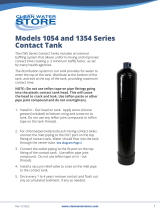
Troubleshooting Tips / Solutions
www.cleanwaterstore.com 17
J-PRO-22 Proportional Peroxide System Installation Guide
Rev-061423
Troubleshooting Tips Solutions
Pump not priming
Ensure the suction line is correctly connected and free from
leaks. The foot valve should be submerged
in the solution.
Make sure tubing is pushed the conical tting until the tubing is
ush against the end of the tting and ttings are tightened.
Pump not injecting solution (chlorine,
peroxide, soda ash, citric acid etc)
Verify the injection check valve is correctly installed and
not obstructed.
Pump losing prime Inspect if the solution tank is empty or if the foot valve
is obstructed.
Pump making loud noise
Pump does make a “ka-thunk” rapping noise when pumping,
this is normal. Consider soundproong the pump with a wooden
or styrofoam enclosure. A rapping or clicking noise is common
when the pump is operating.
Not sure if my JPRO-22 pump is actually
pumping solution
Listen for a ‘ka-thunk” sound when pump is running. If the pump
is primed and pumping you will notice the discharge tubing
slightly twitching and jerking.
Mark the solution level on the solution tank with a piece of tape.
Check again in 1 to 2 days to see if the level has changed.
Pump sounds like it’s pumping but solution is
not going down
Open the priming valve on top of the pump to discharge the
solution back into the solution tank. If it starts pumping, it might
have lost its prime.
Diaphragm might be worn or torn. Replace diaphragm. For
residential use diaphragms typically last 2 to 4 years before
requiring replacement.
Solution can pump out through the priming
valve but won’t pump into the actual piping Ensure the injection check valve is clean and not plugged up.
No sound coming from pump. No lights on
control panel when plugged in or powered up
The pump will need to be replaced. Ensure the pump is not
exposed to power surges.
Entire solution tank empties each day
This could be due to a vacuum being pulled on the JPRO-22 and
your water line sucking solution out of the solution tank. This
is not a pump issue. It’s often caused by a faulty check valve in
the well causing water to run back down the well and creating a
vacuum on the injection check valve.
Pump failure due to power surges or outages
Power surges or outages that cause pump failure are
not covered under warranty. Surge protection is
strongly recommended.
Pump failure due to exposure to freezing
temperatures, direct sunlight, or rain
If the cause of failure is determined to be from exposure to
any of these environments, the pump does not qualify for
replacement and will not be covered under warranty.
Pump leaking from front end (liquid end)
of pump Replace diaphragm and oring set. If pump is several years old the
pump head may also need to be replaced





















